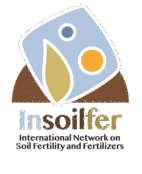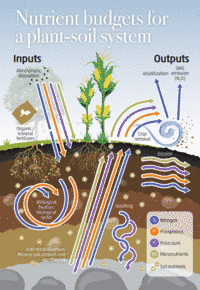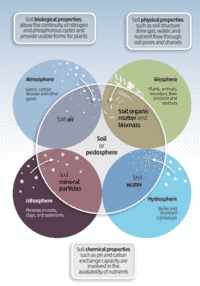
International Network on Soil Fertility and Fertilizers
The International Network on Soil Fertility and Fertilizers (INSOILFER) aims to adopt and implement sustainable soil fertility management, avoid the underuse, misuse and overuse of fertilizers, and reduce the environmental and health impacts of unsustainable fertilizer use. INSOILFER also aims at channeling collective action towards sustainable soil fertility and fertilizer management, with the vision of achieving healthy and fertile soils by 2030 and contributing to the transformation of agrifood systems. For more information contact: Vinisa.SaynesSantillan@fao.org and yuxin.tong@fao.org.
How to get involved
INSOILFER is in the ongoing construction process based on an inclusive and diverse community with various stakeholders with different perspectives on soil fertility and fertilizer management. The network welcomes participation from academia, government, farmers and farmers' associations, industry and private sector, laboratories, extensionists, and technicians. Membership in INSOILFER is free of charge, and active and voluntary participation from each member is encouraged. Please sign in to join the network.
Join INSOILFER
INSOILFER functions and duties
Soil health is the ability of the soil to sustain the productivity, diversity, and environmental services of terrestrial ecosystems (FAO and ITPS, 2020). Efforts and investments focused on increasing plant nutrient uptake and content can be lost if soil management is not sustainable or if soils are not healthy. Suppose soils are compacted, eroded, nutrient-depleted, soil organic matter-depleted, contaminated, acidified, or present salinity problems. In that case, they cannot produce plants that contain nutrients necessary for human health nor assimilate nutrients added by fertilization.
In response to the compounding climate-food-energy-finance crises, it is necessary to produce better (quantity, diversity with quality) with less (fewer inputs of resources, with fewer impacts on the environment) and with equity along the food value chains (from environmental services to consumption). Sustainable soil management is essential to preserve and increase nutrient content in soils, plants, animals, and humans. In concert with soil health, sustainable fertilization is an essential link in the food security chain and should be considered in holistic programs to achieve zero hunger and climate change mitigation.
The network focuses on the sustainable increase of soil fertility, boosting its physical, chemical and biological properties. The GSOIL4N held in 2022 identified the gaps and challenges to the sustainable increase of soil fertility and issued recommendations to overcome soil organic carbon loss, nutrient imbalances, environmental pollution and greenhouse gas emissions (GHG) associated with unsustainable crop practices.
INSOILFER was established based on the recommendations of the Outcome Document of the Global Symposium on Soils for Nutrition (GSOIL4N). The network is a vehicle to implement the International Code of Conduct for the Sustainable Use and Management of Fertilizers and the Voluntary Guidelines for Sustainable Soil Management.
The network's primary goal is to channel collective action towards sustainable soil fertility and fertilizer management, with the vision of achieving healthy and fertile soils by 2030 and contributing to the transformation of agrifood systems.
The overall goals of this new network are:
- Implementation of sustainable and balanced soil fertility management for food security.
- Promotion of actions to enhance the link between nourished healthy soils and crop, animal and human nutrition;
- Avoidance of the underuse, misuse, and overuse of fertilizers
- Strengthening technical and technological capacities through coordination among existing networks.
- Evaluation and improvement of the safety and quality of fertilizers.
INSOILFER operates with three working groups addressing the following themes:
1. Establishment of a soil nutrient monitoring system
• The main focus of the WG1 is on supporting decision-making on soil nutrient management at national and local scales, which is helpful for investment planning and evidence-based recommendations for sustainable fertilizer use. Essential tasks for this WG are identifying key indicators to monitor soil fertility and promoting a data-sharing approach to support soil fertility and nutrient budget mapping in collaboration with the International Network of Soil Information Institutions (INSII).
2. Soil fertility and fertilizer management
• The WG2 promotes sustainable soil management (SSM) and sustainable fertilization practices, which should be widely known and disseminated at the farm scale, emphasizing innovations that optimize nutrient use efficiency such as integrated soil fertility management approaches, increasing fertilizer use efficiency, and implementing nature-based solutions, technological tools, and innovations.
3.Fertilizer safety and quality assessment.
• The objective of WG3 is to monitor and improve the quality and safety of traditional (organic and inorganic) and innovative nutrient sources (biofertilizers, biostimulants, and recycled sources). The International Network on Fertilizer Analysis (INFA) has become the WG3. It focuses on harmonizing methodologies and protocols for the quality and safety assessment of fertilizers and alternative nutrient sources and building and strengthening national capacities of laboratories.
INSOILFER governance is composed of the Chair and three Vice-Chairs leading each one of the working groups, the Technical Committees, and the GSP Secretariat as facilitator and coordinator of the process. INSOILFER members endorsed the governance in the First Working Group Meetings held in November 2023 (see image below). The details of these meetings and the elections are available for consultation HERE. The Terms of Reference considered for electing the Chair, Vice-Chairs, Technical Committees and Reference Institutions are available for consultation in the links below:

Chair and Vice-Chairs INSOILFER Terms of Reference Chair and Vice-Chairs.pdf
Technical Committees INSOILFER Terms of Reference Technical Committees.pdf
Reference Institutions INSOILFER Terms of Reference Institutions_2.pdf
By joining INSOILFER, you contribute to addressing the gaps and challenges to the sustainable increase of soil fertility and issue recommendations to overcome soil fertility loss, avoiding the underuse, misuse and overuse of fertilizers. The members collaborate to avoid nutrient imbalances and contribute to improve soil and fertilizer management. The members exchange knowledge with stakeholders working on the technical aspects of soil fertility and fertilizers.
INSOIFER welcomes representatives from governments, academia, laboratories, the private sector, NGOs, farmers associations, and any other stakeholders from around the world who share the vision of achieving healthy and fertile soils by 2030 and contributing to the transformation of agrifood systems.
If you are interested in joining INSOILFER, please fill out the form to become a part of the network. Once your registration has been processed, your organization will be included on the interactive map showing the location of INSOILFER members (see below). INSOILFER membership is free of charge and its success is based on the active and voluntary participation of each and every one of its members. Upon registration, you will receive details about joining the network, the topics to be addressed, governance structure, operating guidelines, and preparations for working group meetings. Stay tuned for updates and further engagement!
INSOILFER Working Groups
INSOILFER's three Working Groups play a pivotal role in carrying out a range of activities focused on soil fertility and fertilizers. These activities are structured within specific work plans. For comprehensive details regarding the specific initial work plans of each working group, please refer to the concept note.
- WG 1: ESTABLISHMENT OF A SOIL NUTRIENT MONITORING SYSTEM
- WG 2: SOIL FERTILITY AND FERTILIZER MANAGEMENT
- WG 3: FERTILIZER SAFETY AND QUALITY ASSESSMENT
WG1: ESTABLISHMENT OF A SOIL NUTRIENT MONITORING SYSTEM.
The main focus of the WG1is on supporting decision-making on soil nutrient management at national and local scales, useful for investment planning and evidence-based recommendations for sustainable fertilizer use.
The formation of WG1 responds to recommendations of the GSOIL4N Outcome Document, including "Monitor soil nutrients and soil fertility and deepen the knowledge about soil nutrient budget." Based on this recommendation and the gaps and challenges identified during the GSOIL4N , the WG1 addresses three critical aspects for establishing reliable and updated soil fertility monitoring systems.
- Improving the knowledge of the dynamics of the soil nutrient budget. Obtaining reliable, updated, and readily available sources of information on soil nutrient dynamics represents one of the main challenges for developing and improving the knowledge of soil fertility and the nutrient budget (Figure 1). Sustainable soil fertility management and restoration requires a solid understanding of soil nutrient flows, stores, inputs and outputs, and the soil's physical, chemical and biological properties that regulate nutrient availability (Figure 2). WG1 works to understand better soil nutrient dynamics and to identifying key indicators for monitoring nutrient movement to serve as the basis for nutrient balance development and mapping.
- Supporting the decision-making on soil nutrient management, nutrient budget, food security and climate change mitigation at global, national and local scales. The activities and outcomes of WG1 support establishing national soil fertility monitoring systems, innovation, and the development of tools for monitoring and evaluating soil fertility.
- Promoting collective ownership, openness, and innovation in creating novel data-sourcing pipelines and analytical tools to make progress on the knowledge of soil fertility and fertilizers management.
WG2: SOIL FERTILITY AND FERTILIZER MANAGEMENT
The WG2 promotes that sustainable soil management (SSM) and sustainable fertilization practices are widely known and disseminated at the farm scale, emphasizing innovations that optimize nutrient use efficiency.
The objective of WG2 is to promote and disseminate sustainable management of inorganic and organic fertilizers and other nutrient sources through integrated soil fertility management approaches, increasing fertilizer use efficiency, and implementing nature-based solutions, technological tools, and innovations.
These objectives align with the Recommendation 4 included in the GSOIL4N Outcome Document, which advocates for adopting SSM practices since they are the most cost-effective solutions to increase soil nutrient content and fertility. There is no single solution to all soil fertility problems, but a portfolio of alternatives can be employed. Therefore, WG2 directs its efforts toward developing and implementing a portfolio of solutions to avoid the underuse, misuse and overuse of fertilizers, greenhouse gas emissions, and environmental pollution.
The activities of WG2 focus on the following three main aspects:
- The identification, compilation, and promotion of successful field-tested and calibrated soil management practices that have proven to increase fertility, crop nutrition, and crop yields in different types of soils, crops, and climates. These practices include zero or reduced tillage, cover crops, crop rotation, pulses, and nutrition-sensitive agriculture, among others.
- Identifying and promoting fertilization practices that maintain crop yields, preserve soil fertility, and reduce greenhouse gases and environmental pollution, especially water. Examples of these practices are those based on the 4R approach, biofertilizers, precision agriculture, and other innovations.
- The establishment of an environmentally friendly and nutrition sensitive (not exclusively yield-oriented) fertilizer recommendation system.
More information will be available after the Working Groups meetings. Stay tuned!
WG3: FERTILIZER SAFETY AND QUALITY ASSESSMENT
The objective of WG3 is to monitor and improve the quality and safety of traditional (organic and inorganic) and innovative nutrient sources (biofertilizers, biostimulants, and recycled sources). The International Network on Fertilizer Analysis (INFA) has become the WG3. It focuses on harmonizing methodologies and protocols for the quality and safety assessment of fertilizers and alternative nutrient sources and building and strengthening national capacities of laboratories. More information will be available after the Working Groups meetings. Stay tuned!
More information will be available after the Working Groups meetings. Stay tuned!
INSOILFER meetings

“Soil health as a prerequisite for crop production: The relevance of organic fertilizers”
30 January 2024, 13:00 – 15:00 CET
The webinar will take place online on Tuesday 30 January 2024, 13:00 – 15:00 (Central European Time). It is the first in a series of webinars that will be organized by INSOILFER to ..

First Meeting of the INSOILFER Working Groups
Zoom platform | 27-29 May 2023
The International Network on Soil Fertility and Fertilizers (INSOILFER) is one of the seven technical networks coordinated by the FAO Global Soil Partnership (GSP). INSOILFER was launched..
INSOILFER launch
The International Network on Soil Fertility and Fertilizers was launched on 14 July 2023 at a virtual event. More information about the launch event, presentations and recordings are available HERE.
Geographical distribution of INSOILFER members
Related publications
The international Code of Conduct for the sustainable use and management of fertilizers, August 2019 English: doi | FAO card | PDF - French: FAO card | PDF - Spanish: FAO card | PDF - Arabic: FAO card | PDF - Russian: FAO card | PDF - Chinese: FAO card | PDF | ||
Voluntary Guidelines for Sustainable Soil Management PDF in English | French | Spanish | Arabic | Chinese | Russian | Ukrainian | Portuguese | Turkish | Italian | FAO CARDS | ||
NEW RELEASE!
Soils, where food begins: proceedings of the Global Symposium on soils for nutrition, 26–29 July 2022 The book of proceedings of the GSOIL4N contains the papers presented during the Global Symposium on Soils for Nutrition that was held from 26 to 29 July 2022. The papers provide the latest research findings and multisectoral insights which evidenced that nutrient imbalance is a global and crosscutting threat with multifactorial drivers and effects on the agrifood systems and even on key planetary processes. DOWNLOAD HERE | ||
Outcome document of the Global Symposium on soils for nutrition, 26–29 July 2022 Outcome document presents the recommendations that support the implementation of actions and development of policies towards healthy and fertile soils by 2030, allowing the sustainable production of more nutritious and safer food with a climatic and environmentally friendly approach. DOWNLOAD HERE | ||
Soils for nutrition: state of the art This booklet contributes to understanding processes related to soil fertility from the perspectives of food production and food security, and the environmental and climate change impacts associated with fertilizer misuse and overuse. It also outlines the main areas of opportunity and the way forward to solve the nutrient imbalance prevailing in our current agrifood systems. DOWNLOAD HERE | ||
Soils, where food begins: how can soils continue to sustain the growing need for food production in the current fertilizer crisis? ITPS soil letter, issue #6 PDF | FAO Card | ||
World Soil Day - 5 December 2022. Soils, where food begins. Campaign report, June 2023 PDF | ||
Technical guidelines on soils for nutrition: Sustainable soil management for nutrition-sensitive agriculture DOI | PDF | ||
Sustainable soil management as keystone of nutrition sensitive agriculture in Malawi PDF | FAO CARDS | ||
Sustainable soil management as a keystone of nutrition sensitive agriculture in Bangladesh PDF | FAO CARDS | ||
Sustainable soil management as a keystone of nutrition-sensitive agriculture in Burkina Faso PDF | FAO CARDS | ||
Communication material
The International Code of Conduct for the Sustainable Use and Management of Fertilizers
The Fertilizers Code is an instrument that provides a locally adaptable framework and a voluntary set of practices to serve the different stakeholders directly or indirectly involved with fertilizers.
Six actions for farmers to fight nutrient imbalance
Six actions for farmers to fight nutrient imbalance: 1) Assess nutrients need in plants and soils; 2) Maintain a balanced soil pH and include crop rotation; 3) Promote nutrient recycling; 4) Avoid soil compaction and reduce tillage; 5) Protect soil biodiversity and enhance extension services; 6) Control fertilizers quality.
Healthy soils: the foundation of healthy food and a better environment
This video raises awareness on the risks associated with soil nutrient imbalance and soil fertility loss while highlighting the role of soil fertility in producing sufficient, safe, and more nourishing food for healthier plants, animals, and people.
ARABIC | CHINESE | ENGLISH | FRENCH | RUSSIAN | SPANISH | FARSI | ITALIAN | NORWEGIAN | PORTUGUESE | KOREAN



